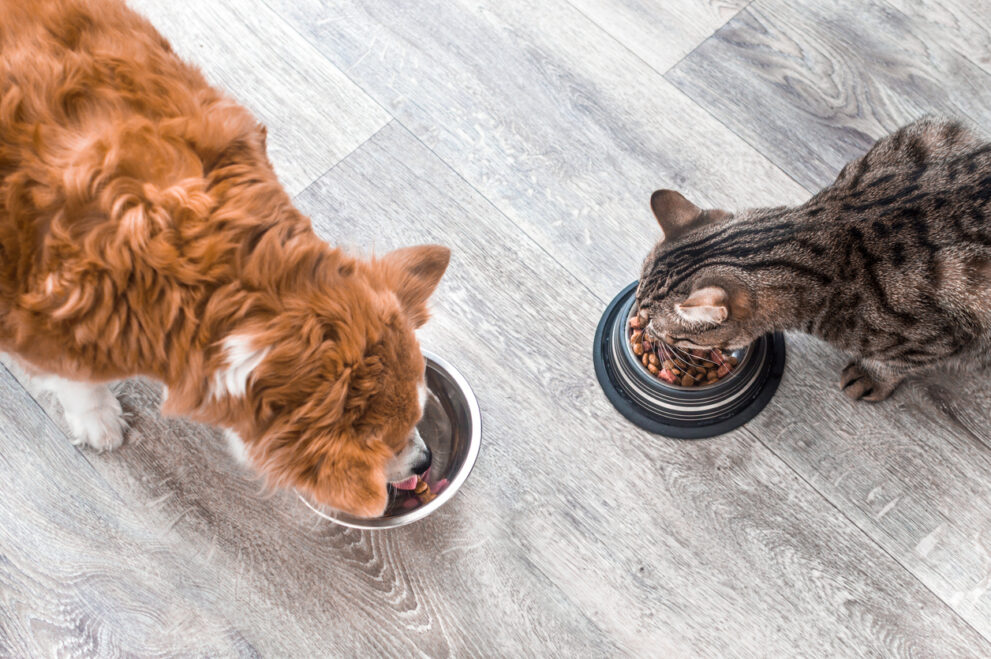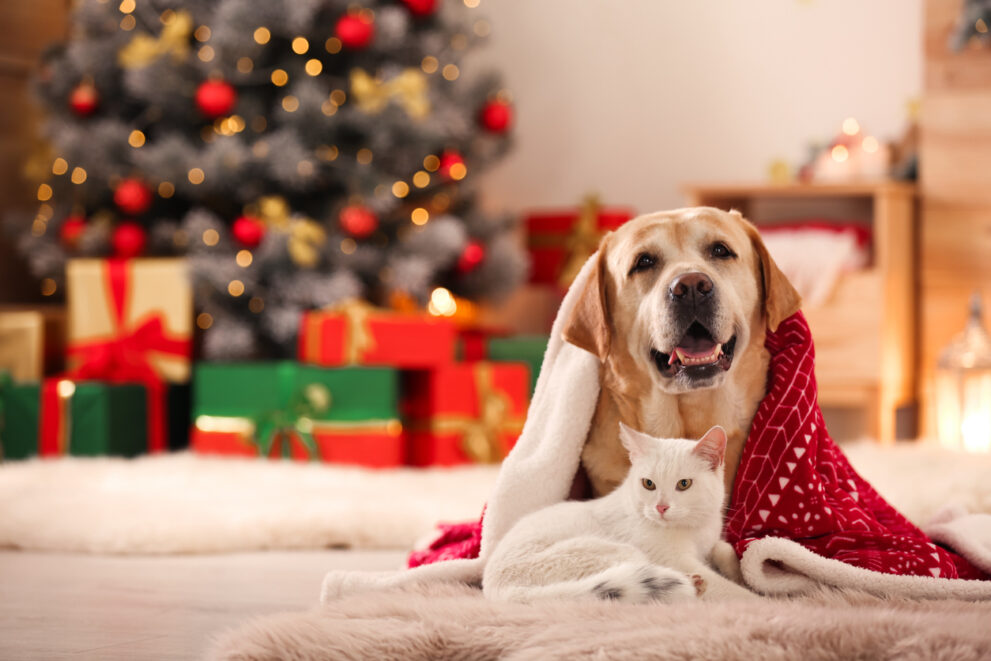“New Year, new me!” How many times have you heard that this January…? New Year’s habits for humans often involve getting fit, eating healthier or sleeping better. Are there any New Year’s resolutions we can assign to our pets too? Let’s discuss…
Dogs
Getting on top of dental hygiene
Dental disease is one of the most common diseases seen in adult dogs, but also one of the most unrecognised. Dental disease describes how bacteria and food debris build-up on the teeth and under the gumline in the mouth. This is often seen as a brown film called plaque – over time, this becomes hard and mineralised and becomes calculus. Far from just being cosmetic, dental disease will lead to bad breath (halitosis), gingivitis (inflamed gums), mouth pain and bleeding, damage to the tooth roots, tooth loss and infection. It can also cause bacteria to spread to the heart, kidneys and other organs, causing damage there. Dental disease is very serious and should not be ignored.
Thankfully, as part of your dog’s New Year’s resolution, we can start to improve their dental hygiene. The primary goal should be brushing, ideally every 1-3 days, using a toothbrush and water. You can use a human child’s toothbrush, or buy dedicated doggy toothbrushes and paste. There are good guides online showing how to brush a dog’s teeth, but build up to it slowly if never done before. Dogs with mineralised calculus may also benefit from enzymatic toothpastes.
Other things that can help dental disease is to increase saliva production via larger kibble or chew toys. These should be firm so they don’t break, but soft enough they don’t damage teeth – if you can press the material with your thumbnail, it’s soft enough. Some of these can incorporate food to act as puzzle feeders for greedy dogs! Many of the rubbery Kong products are great for this.
Remember that advanced dental disease will be impossible to cure with just brushing, and likely requires a dental procedure with a vet to bring their teeth back to a healthy state.
Going out for More Exercise
Many of us neglected our gym memberships or over-ate during Christmas (or both!) and are starting to feel the guilt hit us. If exercising more is on your list, why not include your dog? It’s good to get back into the habit of regular walking, at least once a day depending on your dog. While older and very young dogs should stick to gentle lead exercise, most dogs might like to go for a run in the park or even a swim, great ways to burn calories. You can also throw a toy around if they like to fetch, such as these balls, and a launcher can give them a further distance to run!
When out in winter, it is also important to stay safe. Always keep them on a lead until you are in a safe enclosed area like a dog park. Be careful around roads, especially in the dark. When it is dark, you and your dog should wear something bright and reflective to be more visible to cars, such as a coat or collar, or use a light like this. On the topic of coats, many thin-haired or hairless dogs, or very old or young dogs, benefit from a warm coat.
After a walk, always wash your dog’s paws with cool water and dry them thoroughly. This will stop them getting sore from road grit (and keep the carpets clean!). You could even get them some doggy boots to wear for sensitive paws. Some especially hairy dogs, or one that likes to roll in the mud, may benefit from a nice bath after a long walk – make sure to use a dog-friendly shampoo.
Keeping on top of Parasites
Winter might not bring parasites like fleas, ticks and worms to the forefront of your mind, but many can be present on your dogs all year round. Fleas are the best example of this – in the past, flea numbers did indeed drop off as the weather got cold. Unfortunately, thanks to warm centrally heated houses flea season is now year-round. To prevent itching and sore skin we advise treating dogs monthly (depending on the product) for fleas. Most products will also protect them from mites and ticks, which aren’t as common in winter but can still be encountered.
Worms are also less restricted by the weather since they live inside dogs anyway (though certain parasites picked up from the environment are seen less in winter). These nasty critters can cause diarrhoea, weight loss or lack of weight gain, an itchy bottom and even blood loss. They are especially dangerous to young puppies. On top of this, many are zoonotic and can infect humans too. We advise dogs are wormed regularly. Dogs that are fed raw meat, scavenge from the floor, eat poo, slugs or snails, or are very active outdoors like working dogs, should be wormed more frequently – again, this is primarily to protect human health, especially young children.
Many flea and worming products require a prescription from your own vet before we can supply them. We stock a wide range of professional products, available with a prescription from your vet (for POM-V products). Alternatively, our in-house prescribers can supply you with Droncit and Drontal for worms; and a wide range of non-POM-V flea and tick treatments.
Managing Anxiety and Fear.
Many dogs are nervous or have anxiety, and the winter seems to be a common time where it gets worse. Thanks to fireworks, flashing decorative lights, darkness and other changes to their lives, we often get asked what we can do to calm these dogs.
In an ideal world, dogs should be prepared for these events as puppies. This may involve gradual acclimatisation to loud noises using videos or CDs, puppy classes to build confidence and reduce separation anxiety, and plenty of socialisation. With early training, many dogs grow to be confident and are less likely to have anxiety or fears later in life.
However, this isn’t always possible, so for adult dogs showing fear in winter, consider creating a safe space with lots of blankets, bedding, dim lights, and food and water (again, ideally in advance). They may also benefit from the TV or radio playing to mask noises, and the curtains closed to block light. Some dogs respond well to calming pheromones that you can purchase as plug-in diffusers, tablets or even collars. Plus there are herbal based calming products and a calming supplement which uses a particular milk protein. Very severe cases of phobias may require veterinary assistance, with behavioural therapy or medication such as topical dexmedetomidine gel or imepitoin tablets. Remember these products are restricted drugs that can only be bought with a veterinary prescription.
Cats
Going Outdoors
With their thick fur and powerful eyes, most cats are pretty happy going out and about in winter. In the New Year, make sure they stay safe. The first step is to ensure they are microchipped by a vet, and the chip is registered to your name and address. The government is planning to make this compulsory to all cats, as they previously did with dogs, so now is the best time to get it sorted! This way, if they ever go missing and are taken to a vet or shelter, they can be reunited with you. Some collars even say “I’m microchipped” to help remind good Samaritans to check.
On the topic of collars, it’s a good idea for most outdoors cats to have one. These should be not too loose to get caught, but not too tight to restrict your cat’s movement. Always ensure they are breakaway collars, so if your cat does get caught, they won’t be trapped. In dark winter nights, they will benefit from being reflective too. If you are especially environmentally conscious, you might want to fit a bell to warn small animals and birds to run away from your hunting cat! We have a range of safe, durable cat collars available on our website. Even cats that are kept indoors might like to venture out now and then. For these cats, a harness and lead would be a great way to keep them from running away while giving them some fresh air.
Having Fun Indoors
Staying indoors doesn’t mean cats can’t have fun! As well as providing enrichment and bonding with their owner, any extra exercise can help keep cats lean instead of putting on winter coverage! There’s lots of ways to do this. You can start simple and see if they enjoy playing with an old cardboard box or toilet roll tube (hiding kibble inside can be a good motivator), or even just moving their food bowl upstairs so they have to move to eat.
If you’re looking for some toys, many cats like chasing things, like balls, toys on a string or laser pointers. It’s a good idea to reward them with something to actually ‘kill’ afterwards, such as a small piece of food, so they don’t have a frustrating ‘hunt’. Some may also enjoy catnip-laced products.
Caring for Old Cats
Like many old humans, old cats often struggle in winter. The cold is felt more if they are underweight, and many older cats will have osteoarthritis that can be more painful during this time. They may also be more skittish, so struggle with the changes that Christmas and the New Year bring.
When the weather is cold and wet outside, why not keep your elderly cat warm inside with a new blanket, bed or nest to hide in? Some are even designed to clip onto radiators, like this one, to act as heated blankets (just be careful of fire hazards). If you can, keeping the ambient temperature of the house slightly warmer will help too. Older cats also tend to groom themselves less, often struggling due to sore joints, so keep them healthy with regular brushing, nail clipping or providing scratching posts.
On the topic of sore joints, we recommend that teenage cats should be regularly health-checked by a vet – many elderly cats have osteoarthritis that can affect their mobility, comfort and exercise tolerance. There are lots of joint supplements you can purchase over the counter, such as YuMove or Synoquin, though many cats with advanced OA need stronger prescription painkillers too. On top of this, diseases like heart disease, kidney disease and hyperthyroidism are also very common. Early diagnosis can improve the prognosis, so don’t delay your cat’s health-checks.






